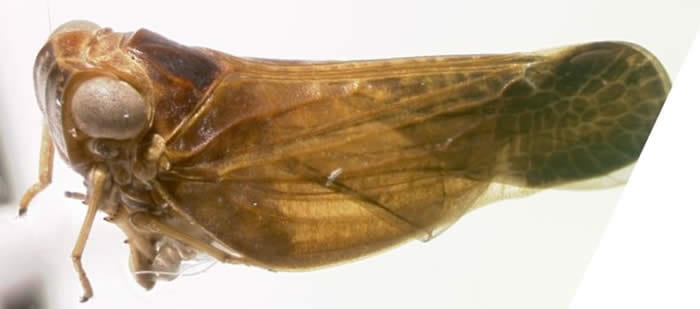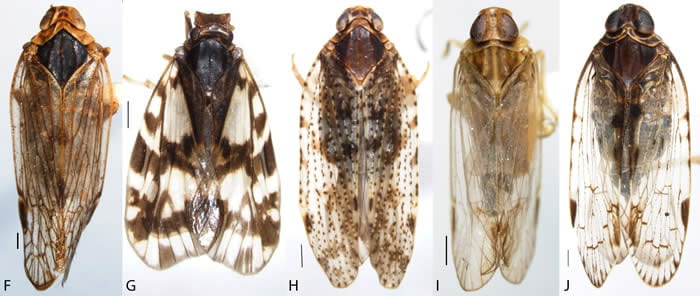The following identification key should serve to identify all families of planthoppers found north of Mexico. It has been adopted (with slight modification) from Bartlett et al. (2014) (images mostly from this work). This includes the families Acanaloniidae, Achilidae, Caliscelidae, Cixiidae, Delphacidae, Derbidae, Dictyopharidae, Flatidae, Fulgoridae, Issidae, Kinnaridae and Tropiduchidae. Also, recently the Colpopterini have been moved to the Nogodinidae (as a subfamily), and so the key has been modified from Bartlett et al. (2014) to separate Colpoptera (a single species adventive in Florida, formerly in Issidae).
I am developing an overview of phylogenetics (family level), from the historical prospective here, but it is still quite incomplete.
Key to planthoppers families found north of Mexico.
1. Hind tibiae with large, apical movable spur (the calcar, see Figure 1, below), spur usually flattened, foliaceous, and bearing a row of black-tipped teeth on the posterior (trailing) margin; rarely spine-like; insects mostly less than 4.0 mm. … Delphacidae
1’. Hind tibiae without apical movable spur … 2
Figure 1. The calcar of Delphacidae (top to bottom), Neomegamelanus, Delphacinae, Delphacini; Kelsia, Kelisiinae; Asiraca, Asiracinae; Tropidocephala (Delphacinae, Tropidocephalini).
2. Second hind tarsomere with two apical spines (1 on each side, Figure 2A) and with tarsomere apex truncate or conical … 3
2’. Second hind tarsomere with row of apical spines (Figure 2B-C) and with apex truncate or emarginate … 8
Figure 2. Hind tarsus of planthoppers. A. Hind tarsus of Acanalonia conica (Acanaloniidae), ventral view, B. hind tarsus of Melanoliarus placitus (Cixiidae), ventral view; C. hind tarsus of Synecdoche impunctata (Achilidae), ventral view (from Bartlett et al. in 2014).
3. Clavus with numerous small, pustule-like tubercles (Figure 3C-D); front wings longer than body, with submarginal costal vein and numerous parallel crossveins in ‘precostal’ area (Figure 3C, i.e., on leading margin of wing) defining a series of marginal cells, at rest held almost vertical at sides of body (except in the Flatoidinae); wings usually waxy … Flatidae
3’. Clavus without pustule-like tubercles (except along claval vein in some Derbidae, Figure 3E); front wings usually without numerous costal crossveins; wing position at rest variable … 4

Figure 3 Features of planthoppers. A. wings of Cyrpoptus vanduzeei (Fulgoridae), B. wings of Diacira setifera (Dictyopharidae), C. lateral habitus of Flatormenis saucia (Flatidae), D. clavus of Flatormenis saucia, E. clavus of Omolicna sp. (Derbidae) (from Bartlett et al. 2014).
Figure 3. Features of planthoppers. A. wings of Cyrpoptus vanduzeei (Fulgoridae), B. wings of Diacira setifera (Dictyopharidae), C. lateral habitus of Flatormenis saucia (Flatidae), D. clavus of Flatormenis saucia, E. clavus of Omolicna sp. (Derbidae) (from Bartlett et al. 2014).
4. Front wings with a series of crossveins between costal margin and apex of clavus setting off a distinct nodal line and a differentiated apical reticulate area (Figure 4G); wings macropterous and longer than abdomen; frons with 3 (not 5) carinae (all recorded U.S. species in southeast) … Tropiduchidae (Tangiini & Remosini; Tropiduchidae in the usual sense)
4’. Front wings without differentiated apical portion; wings variable in length … 5
Figure 4. Features of planthoppers. F. forewing of Achilidae (Synecdoche grisea), G. dorsal habitus of Tropiduchidae (Tangia viridis (Walker 1851), British Virgin Islands) (from Bartlett et al. 2014).
5. Front wings broad, longer than body, held almost vertically at sides of body, venation irregularly reticulate (Figure 5); hind tibiae without spines except at apex (Figure 6D); usually green (rarely pink, yellow to brown in Philatis, Fig. 5D); pronotum not extending anteriorly much beyond posterior aspect of eyes; ovipositor laterally compressed … Acanaloniidae
5’. Front wings variable, may be shorter than abdomen; hind tibiae usually with 1 – 4 subapical spines (Figures 6E-G); ovipositor not laterally compressed (if so, pronotum will extend anteriorly beyond middle of eyes) … 6
Figure 5. Lateral views of Acanaloniidae (scale = 1.0 mm). A. Acanalonia clypeata, B. A. conica, C. A. fasciata, D. Philatis tuberculata.
Figure 6. Hind legs of planthoppers showing teeth on tibia. D. hind tibia of Acanalonia conica (Acanaloniidae) (no tibial teeth); E. Hind tibia of Aphelonema simplex (Caliscelidae) (1 tibial tooth); F. hind tibia of Thionia elliptica (Issidae) (2 tibial teeth), G. hind tibia of Picumna chinai (Issidae) (4 tibial teeth).
6. Usually brachypterous, wings much shorter than abdomen (Figure 7), venation not reticulate; hind tibiae with single lateral spine (Figure. 6E); front tibiae sometimes greatly expanded (Figs. 6D-E), face sometimes projecting as “weevil-like” snout (Figs. 6C, E); small insects, mostly grass feeders … Caliscelidae
6’. Wings usually extending to or beyond apex of abdomen, including brachypters (except Osbornia, Figure 17J); venation often reticulate; hind tibiae with 1-4 lateral spines (Figs. 6F-G); front tibiae never greatly expanded, face not projecting, size variable … 7
Figure 7. Lateral views of Caliscelidae (scale = 0.5 mm). A. Aphelonema rugosa, B. Asarcopus palmarum (male), C. Bruchomorpha oculata, D. Caliscelis bonellii (male), E. Fitchiella rufipes, F. Papagona succinea.
7. Forewings reticulate (Figure 17), with some cells clear and membranous; pronotum often projecting forward beyond middle of eyes; clypeus usually strongly carinate … Tropiduchidae (was Gaetuliini, now Elininae, Elicini; this group formerly in Issidae, subsequently moved to Nogodinidae then to Tropoduchidae)
7’. Forewings rarely reticulate (Figure 18), if reticulate (Fig. 18F, J), without clear membranous cells; pronotum usually not projecting anteriorly beyond middle of eyes; clypeus often not carinate … Issidae (including Colpopterini, Nogodinidae) … 7a.
7a. Posterior tibiae with 1 spine (similar to Figure 6E); narrow, elongate planthoppers (Figure 19); adventive, Florida … Colpoptera (Nogodinidae)
7a.’ Posterior tibiae with 2-4 spines (Figs. 6F-G); broad, stout planthoppers (Figure 18, bottom of page); widespread … Issidae
Figure 19. Colpoptera species (Nogodinidae sensu Gnezdilov 2013) adventive to Florida (photo courtesy Susan Halbert, FSCA).
8. Large species (10mm+), forewing (and hindwing) usually colored (Figure 3A), opaque and slightly thickened, held slightly tectiform; venation usually reticulate; anal area of hind wing with crossveins; head sometimes (e.g., Rhabdocephala) projected (but this is more common in tropical forms) …. Fulgoridae
8’ Usually smaller species, if 10+mm then forewing usually clear, membranous; hind wing not reticulate (Figure 3B, without crossveins), but if reticulate only at apical area beyond clavus; head rarely projected (except Dictyopharidae) … 9
9. Terminal segments of the beak short, subequal in length and width (Figure 8H); often with pustules along claval vein of wing (e.g., Figure 3E); frons often narrowed with median carina absent or obscured (Figure 9); males with parameres (gonostyli) exceeding abdomen in ventral view, many forms fragile with wings greatly surpassing end of the abdomen … Derbidae
9’. Terminal segment of beak much longer than wide (Figure 8I); clavus without pustules, male parameres (gonostyli) not exceeding abdomen … 10
Figure 8. Features of planthoppers. H. beak of Anotia westwoodi (Derbidae, terminal beak segment short), I. beak of Bothriocera cognita (Cixiidae, terminal beak segment long).
Figure 9. Features of planthoppers, front of Derbidae. H. Omolicna texana (paratype), I. Persis ferox, J. Patara cyanea Fennah, 1952 (from Dominica).
10. Front wings distinctly overlapping at apex (Figure 10), and concave on commissural (trailing) margin in most taxa (Figure 4F); clavus closed, with united claval veins entering apex; body somewhat flattened … Achilidae
10’. Front wings not overlapping at apex (or only slightly) (e.g., Figure 11); claval vein not reaching apex of clavus; not particularly flattened … 11
Figure 10. Dorsal view of Achilidae (scale = 0.5 mm). E. Catonia picta, F. Cixidia septentrionalis, G. Juniperthia indella, H. Momar maculifrons.
Figure 11. Dorsal view of Cixiidae. F. Asotocixius diopter (paratype), G. Bothriocera cognita, H. Cixius pini, I. Haplaxius radicis, J. Melanoliarus placitus.
11. Head prolonged in front (e.g. Figures 12-14), or frons with 2-3 median carinae (i.e., 4-5 total carinae on face); or (in brachypterous forms, particularly Orgeriinae, e.g., Figure 14) tegulae are hidden and claval suture obscure; median ocellus absent … Dictyopharidae
11’. Head not prolonged in front, frons with single median carinae (rarely none); tegulae present; claval suture distinct; median ocellus often present just above frontoclypeal suture (e.g., Figure 16A) …. 12
Figure 12. Dictyopharidae (Dictyopharinae), B. Nersia florens, C. Rhynchomitra microrhina (from Bartlett et al. 2014).
Figure 13. Dictyopharidae (Dictyopharinae). H. Scolops (Scolops) sulcipes, I. Scolops (Belanocharis) abnormis (from Bartlett et al. 2014).
Figure 14. Dictyopharidae (Orgeriinae). E. Acinaca lurida, F. Aridia compressa, G. Deserta obscura, H. Orgamara argentia (from Bartlett et al. in press).
12. Abdominal terga 6-8 “chevron-shaped” (at least in females, Fig. 15E), sometimes sunk below rest of terga; females with reduced ovipositor; 3-4 mm; forewing veins usually without pustules or setae (Figure 16); usually only 2 rows of crossveins, southwestern U.S. only … Kinnaridae (Oeclidius)
12’. Abdominal terga normal, females with distinct, elongate ovipositor (Figure 15F); variable in size, often larger than 4 mm (Figure 11); forewing veins usually pustulate and/or setigerous; common and widely distributed … Cixiidae
Figure 15. Ovipositor of Cixiidae (F, left, ventral view), tergites of Kinnaridae (E., dorsal view, Quilessa fasciata).
Figure 16. Views of Kinnaridae (Oeclidius sp.), frons (A., left), dorsal habitus (E, right).
Figure 17. Lateral habitus of Tropiduchidae (Gaetuliini; scale = 1.0 mm). A. Danepteryx lurida, B. Dictyobia semivitrea, C. Dictyonia obscura, D. Dictyonissus griphus, E. Dictyssa monroviana, F. Dictyssonia beameri, G. Dyctidea sp., H. Misodema reticulata, I. Neaethus sinehamatus, J. Osbornia cornuta. (from Bartlett et al. 2014)

Figure 18 . Lateral habitus of Issidae (scale = 1.0 mm). A. Abolloptera bistriata, B. Agalmatium bilobum (photo by L. B. O’Brien), C. Balduza una, D. Exortus fuscomaculus, E. Kathleenum cornutum, F. Paralixes scutatus, G. Picumna chinai, H. Stilbometopius auroreus, I. Thionia bullata, J. Traxus fulvus, K. Tylanira bifurca. (from Bartlett et al. 2014)
Bartlett, C.R., L.B. O’Brien and S.W. Wilson. 2014. A review of the planthoppers (Hemiptera: Fulgoroidea) of the United States. Memoirs of the American Entomological Society 50: 1-287.























